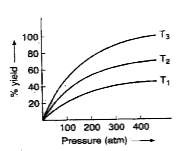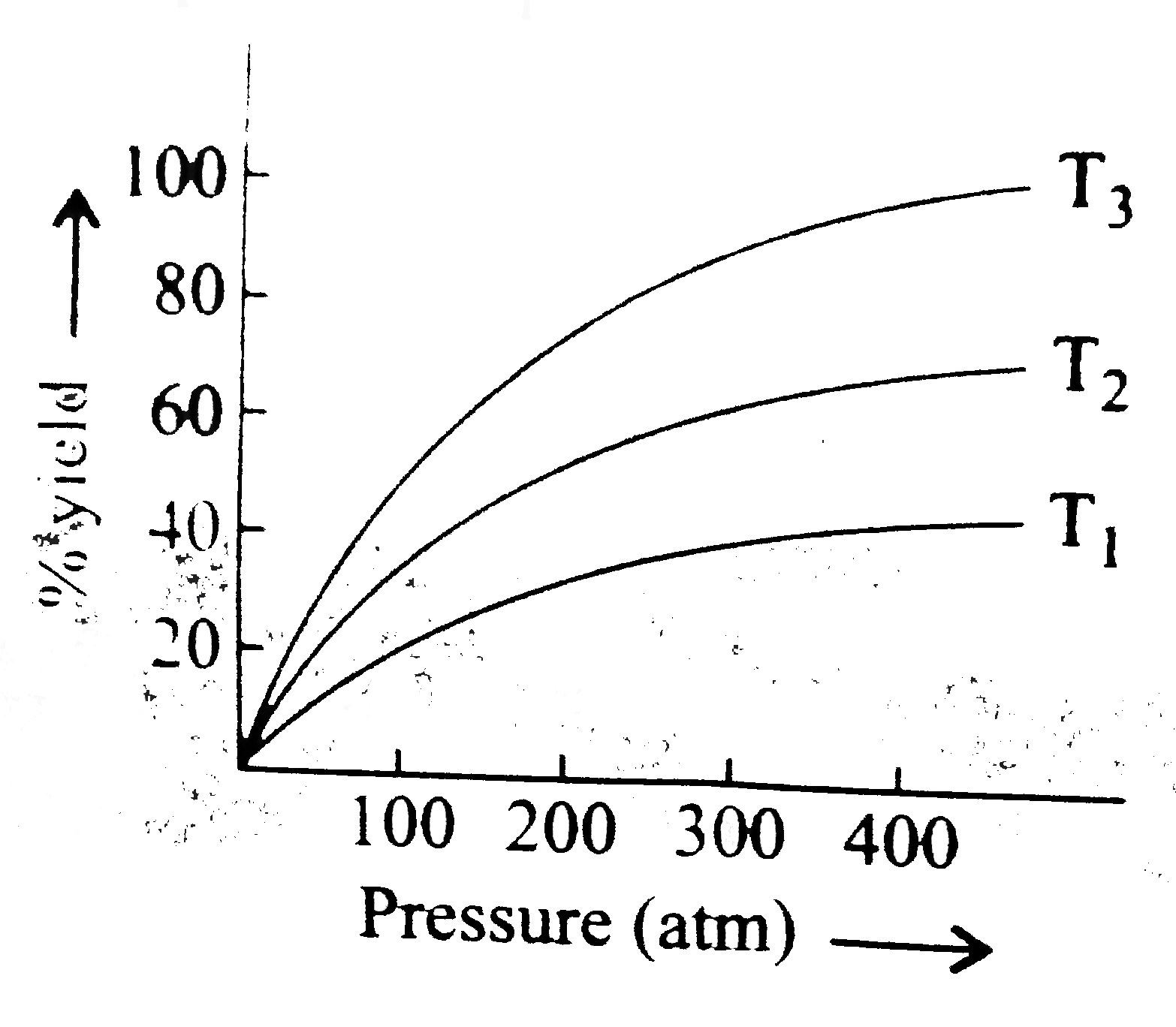In Haber's process, ammonia is manufactured according to the following reaction
N2(g)+3H2(g)⇔2NH3(g),ΔH∘=−2.4kJ
The pressure inside the chamber is maintained at 200 atm and temperature at 500∘C. Generally this reaction is carried out in presence of Fe catalyst.
The preparation of ammonia by Haber's process is an exothermic reaction. If the preparation follows the following temperature pressure relationship for its % yield. Then for temperature T1,T2 and T3, the correct option is :
 Solution in Malayalam
Solution in Malayalam
T3<T2<T1
T3>T2>T1
T1=T2=T3
T1>T2<T3
The correct Answer is:B
The % yield will decrease with rise in temperature since it is exothermic.
Topper's Solved these Questions
- CHEMICAL AND IONIC EQUILIBRIUMBOOK - BRILLIANT PUBLICATIONCHAPTER - CHEMICAL AND IONIC EQUILIBRIUMEXERCISE - Level - III (Linked Comprehension Type Questions)
1 Videos
- CHEMICAL AND IONIC EQUILIBRIUMBOOK - BRILLIANT PUBLICATIONCHAPTER - CHEMICAL AND IONIC EQUILIBRIUMEXERCISE - Level - III (Statement Type)
6 Videos
- CHEMICAL BONDINGBOOK - BRILLIANT PUBLICATIONCHAPTER - CHEMICAL BONDINGEXERCISE - LEVEL-III ( Linked Comprehension Type )
12 Videos
Similar Questions
The degre of dissociation of weak electrolyte is inversely proportional to the same square root of concentration. What is called Ostwald's dilution law.
α=√Kac As the temperature increases, degree of dissociation will increase.
α1α2=√Ka1Ka2 if concentration is same. α1α2=√c2c1 if acid is sam.
For two monobasic acids HA1 and HA2 at the same concentration α1 and α2 are in ratio of 1:2. Ka1=2×10−4. What will be Ka2 ? 8×10−4, 2×10−4, 4×10−4, 1×10−4
View SolutionAssertion : Adding inert gas to dissociation equilibrium of N2O4 at constant pressure and temperature increases the dissociation.
Reason : Molar concentration of the reactants and products decrease.
View SolutionIn an ionic bond, the cation tends to polarize the electron cloud of the anion by pulling electron dens towards itself. This causes development of covalent character in the ionic bond because the electron dens gets localised in-between the nuclei. The tendency of the cation to bring about the polarization of the anion expressed as its polarizing power. The ability of ion to undergo polarization is called its polarisability. The polarising power of a cation or an anion is decided on the basis of Fajans' rules.
The ionic conductance of which of the following is the highest?
View SolutionN_(2)(g)+3H_(2)(g) hArr 2NH_(3)(g), DeltaH^(ɵ)=-22.4 kJ The pressure inside the chamber is 100 atm and temperature at 300 K The preparation of ammonia by Haber's process is an exothermic reaction. If the preparation follows the following temperature-pressure relationship for its % yield. Then for temperature T_(1), T_(2) and T_(3) the correct option is:
View SolutionN_(2)(g)+3H_(2)(g) hArr 2NH_(3)(g), DeltaH^(ɵ)=-22.4 kJ The pressure inside the chamber is 100 atm and temperature at 300 K On adding catalyst the equilibrium of reaction:
View SolutionN_(2)(g)+3H_(2)(g) hArr 2NH_(3)(g), DeltaH^(ɵ)=-22.4 kJ The pressure inside the chamber is 100 atm and temperature at 300 K 30 L H_(2)(g) and 30 L N_(2)(g) were taken for the reaction in Haber's process which yields only 50% of the expected ammonia due to reversibility of the reaction. What will be the composition of reaction mixture under the given condition?
View SolutionIn the manufacture of ammonia by Haber's process, N_(2)(g) +3H_(2)(g) hArr 2NH_(3)(g)+92.3kJ , which of the following conditions is unfavourable ?
View SolutionAssertion : Haber's synthesis of NH3 is carried out in the presence of a catalyst.
Reason: the catalyst shifts the position of the equilibrium of the reaction
N2(g)+3H2(g)⇔2NH3(g) to the product side.
View SolutionIn the manufacture of ammonia by Haber's process,
N2(g)+3H2(g)⇔2NH3(g)+92.3kJ, which of the following conditions is unfavourable ?
View SolutionIn Haber's process of manufacture of ammonia, the Fe catalyst is poisoned by the pressure of .............
View SolutionIn the manufacture of ammonia by Haber's process, N2(g)+3H2↔2NH3(g)+92.3kJ, which of the following conditions is unfavourable
View SolutionN2(g)+3H2(g)200 Atm⇐==⇒Fe2NH3(g) , At which temperature this reaction will be possible ?
View SolutionN2(g)+3H2(g)⇔2NH3(g),ΔHɵ=−22.4kJ
The pressure inside the chamber is 100 atm and temperature at 300K
The preparation of ammonia by Haber's process is an exothermic reaction. If the preparation follows the following temperature-pressure relationship for its % yield. Then for temperature T1,T2 and T3 the correct option is:

View SolutionN2(g)+3H2(g)⇔2NH3(g),ΔHɵ=−22.4kJ
The pressure inside the chamber is 100 atm and temperature at 300K
On adding catalyst the equilibrium of reaction:
View SolutionIn the manufacture of ammonia by Haber's process,
N2(g)+3H2(g)⇔2NH3(g)+92.3kJ, which of the following conditions is unfavourable ?
View SolutionIn the manufacture of ammonia by Haber's process, N_(2(g))+ 3H_(2(g))Leftrightarrow 2NH_(3(g))+ "92.3 kJ" , which of the following conditions is unfavourable?
View Solution
